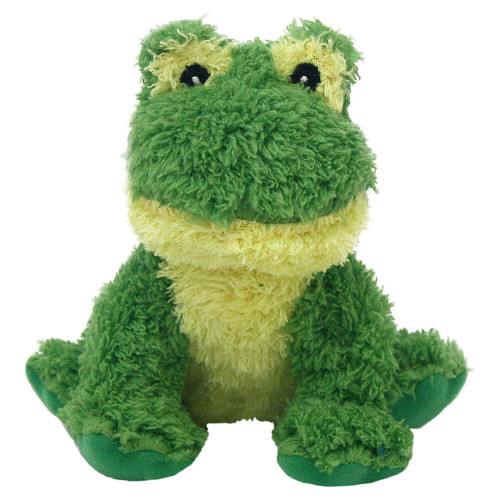Wooly Puppies
Ok, we've been asked quite often "How can you tell if it's going to be a wooly?" (that's after you hear "what is a wooly?") A wooly is a malamute with excessively long and sometimes very dense coat. Sometimes it's just behind the ears at first, but usually after their 3rd birthday they explode into all their glorious "wooly-ness". Some are born quite densely coated and it's easy to tell. With others, you aren't always as sure (especially the "just behind the ears" wooly coats). Either way, it's a lot of hair.On the bright side, they usually don't shed like a normal coat - all that hair tends to stay put until it's combed out. (or at least most of it does) This presents some problems if the owner isn't willing to groom regularly as a wooly coat is more likely to matt. Matts are very bad for a dog's skin. They'll tighten when they get wet, and become very sore and painful. If left long enough, I've heard of horrible sores developing and then maggots will get in the sores - particularly with an outdoor dog! I'm sure every malamute rescue has dealt with this at one time. A very sad and miserable situation for the dog. However, if a wooly is groomed regularly and well, the coat can be stunning!
The reason it's not correct is that in the arctic there are tales of woolies that got wet and froze to the ice - or that drowned because the weight of the coat pulled them underwater. I think mainly it's not correct because theAKC standards says so. You often see woolies on sled teams in the coldest climates and it doesn't seem to be much of a problem. Much of the high-arctic is a DESERT - which means it stays extremely cold at all times and there is not much precipitation.However, in climates that do have rain or wetter snow, it IS a problem. The coat when loaded with snow and rain will "part" - and the cold can get to the dog's skin. In very cold temperatures, this can be devastating and deadly. Exposed skin gets frostbite and frostbite can lead to gangrene. A wet dog dies.
Wooly feet tend to collect and hold ice balls. This of course is going to be painful for the dog and can lead to lameness. Lameness is deadly and not desired if you are an Inuit hunter out on the sea ice.On the other hand, woolies are necessary. The gene that causes the extra length of coat is a simple recessive. This means it will appear in one fourth of the puppies if even one parent is just a carrier (doesn't have a wooly coat but carries the gene for it). If one parent IS a wooly, 1/2 of the puppies will be wooly. If you breed two dogs that do not carry the gene at all, you tend to have shorter, siberian length coats- not the lush thick malamute coat expected. So woolies are necessary to a breeding program. They are not evil, nor are they necessarily a bad thing. They make fantastic petsand seem to be especially loving and friendly. The Inuit were trying to survive - a trip to the groomers just wasn't going to happen! But perhaps the Inuit allowed one or two particularly sweet pups to survive. Perhaps they stayed in the shelter as living blankets. Maybe that's why woolies always seem to be the sweetest, most loving pups in the litter! I'm only speculating here, but as pets, especially in a modern society that has the time and resources to groom themproperly, they make great additions to a family.
While no breeder should be breeding FOR woolies, they are a necessary and important part of the Alaskan Malamute genetics. They are not something you want to eradicate entirely. Nor do you want to ONLY breed for a coat that is not correct. It becomes like everything else in breeding - making choices. I would always use a excellent tempermented great structured wooly over a poorly structured nasty normal coat! It's just not something you want to do every time (or all you'll produce is woolies).
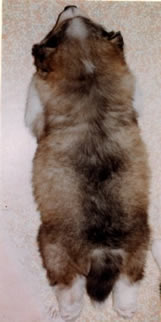 Gus-wooly
Gus-wooly 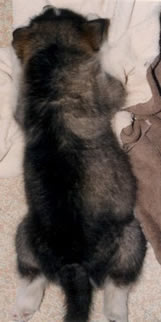 Louis-not
Louis-not 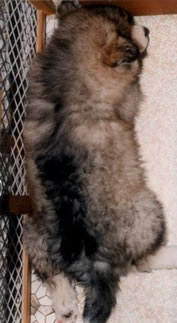 Ode-wooly
Ode-wooly 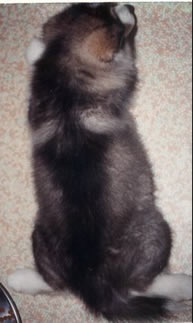 Shadow-not
Shadow-not 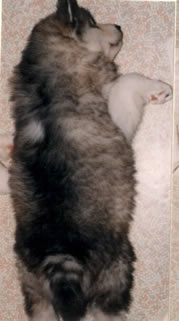 Stormy-wooly
Stormy-wooly 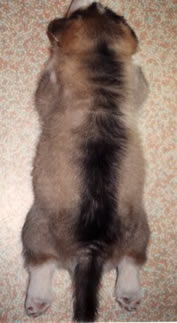 Star-not
Star-not 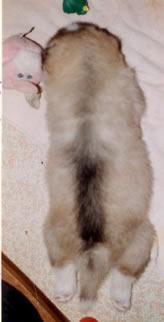 Indy-not
Indy-not 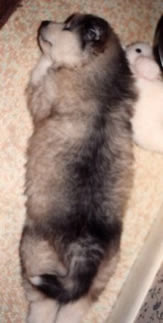 Tova-wooly
Tova-wooly 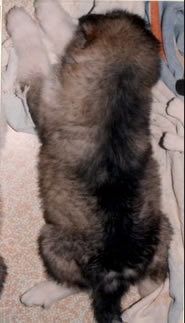 Holly-wooly
Holly-woolySo how do you tell who will and will not be woolies when they grow up? The truth be told, it's hard to tell on someone elses lines. There seems to be various kinds of woolies out there. Also, what one person might call a wooly, another will call a "fancy show coat". So the whole thing gets mired in opinion. Obviously, Harley was a wooly: There is enough coat there for two or three malamutes! But it becomes more confusing when you have dogs that are apparently only wooly on their heads and tails. Or that have a longer coat, without a lot of undercoat. Or have a lot of undercoat, but the guard isn't particularly long so they appear normal, just fluffy (a fancy coat). Then you start to get into shades of gray. Some have tried to solve this problem by calling them "long-coats" and "wooly-coats". Meaning if the guard coat is too long (without a long undercoat) it's a long-coat. If the undercoat is long it's a wooly-coat. If both undercoat and guard are long...you have Harley!
Below are various examples of woolies we've had. Kava is really only long on his head and tail...the rest of his coat might even be considered correct. It's the fluff behind the ears that gives them away as puppiesand a generally fluffier appearance when compared to siblings. As they grow up, they tend to get even fluffier.
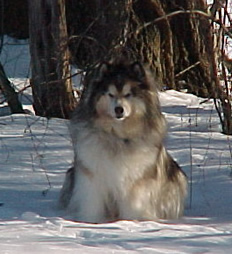
Harley - the ultimate wooly
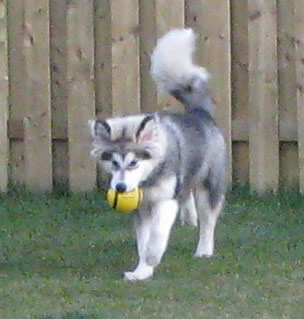
Kava
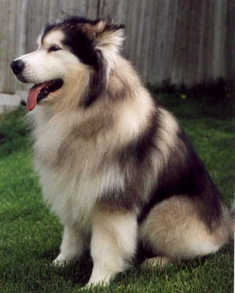
Homer
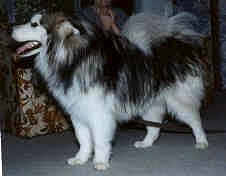
Stormy
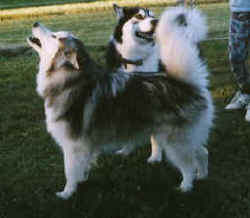
Tova
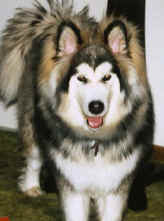
Ode

Holly



